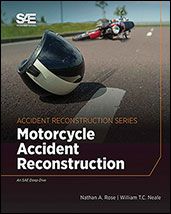Technical Paper
Speed Analysis from Video: A Method for Determining a Range in the Calculations
2021-04-06
2021-01-0887
This paper introduces a method for calculating vehicle speed and uncertainty range in speed from video footage. The method considers uncertainty in two areas; the uncertainty in locating the vehicle’s position and the uncertainty in time interval between them. An abacus style timing light was built to determine the frame time and uncertainty of time between frames of three different cameras. The first camera had a constant frame rate, the second camera had minor frame rate variability and the third had more significant frame rate variability. Video of an instrumented vehicle traveling at different, but known, speeds was recorded by all three cameras. Photogrammetry was conducted to determine a best fit for the vehicle positions. Deviation from that best fit position that still produced an acceptable range was also explored. Video metadata reported by iNPUT-ACE and Mediainfo was incorporated into the study.


